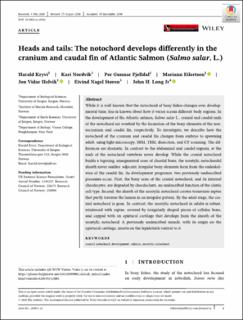Heads and tails: The notochord develops differently in the cranium and caudal fin of Atlantic Salmon (Salmo salar, L.)
| dc.contributor.author | Kryvi, Harald | |
| dc.contributor.author | Nordvik, Kari | |
| dc.contributor.author | Fjelldal, Per Gunnar | |
| dc.contributor.author | Eilertsen, Mariann | |
| dc.contributor.author | Helvik, Jon Vidar | |
| dc.contributor.author | Støren, Eivind Wilhelm Nagel | |
| dc.contributor.author | Long, John H. | |
| dc.date.accessioned | 2021-05-04T14:19:33Z | |
| dc.date.available | 2021-05-04T14:19:33Z | |
| dc.date.created | 2020-12-18T14:17:27Z | |
| dc.date.issued | 2020 | |
| dc.Published | Anatomical Record Part A: Discoveries in Molecular Cellular and Evolutionary Biology. 2020, 1-21. | |
| dc.identifier.issn | 1552-4884 | |
| dc.identifier.uri | https://hdl.handle.net/11250/2753554 | |
| dc.description.abstract | While it is well known that the notochord of bony fishes changes over developmental time, less is known about how it varies across different body regions. In the development of the Atlantic salmon, Salmo salar L., cranial and caudal ends of the notochord are overlaid by the formation of the bony elements of the neurocranium and caudal fin, respectively. To investigate, we describe how the notochord of the cranium and caudal fin changes from embryo to spawning adult, using light microscopy, SEM, TEM, dissection, and CT scanning. The differences are dramatic. In contrast to the abdominal and caudal regions, at the ends of the notochord vertebrae never develop. While the cranial notochord builds a tapering, unsegmented cone of chordal bone, the urostylic notochordal sheath never ossifies: adjacent, irregular bony elements form from the endoskeleton of the caudal fin. As development progresses, two previously undescribed processes occur. First, the bony cone of the cranial notochord, and its internal chordocytes, are degraded by chordoclasts, an undescribed function of the clastic cell type. Second, the sheath of the urostylic notochord creates transverse septae that partly traverse the lumen in an irregular pattern. By the adult stage, the cranial notochord is gone. In contrast, the urostylic notochord in adults is robust, reinforced with septae, covered by irregularly shaped pieces of cellular bone, and capped with an opistural cartilage that develops from the sheath of the urostylic notochord. A previously undescribed muscle, with its origin on the opistural cartilage, inserts on the lepidotrich ventral to it. | en_US |
| dc.language.iso | eng | en_US |
| dc.publisher | Wiley | en_US |
| dc.rights | Attribution-NonCommercial-NoDerivatives 4.0 Internasjonal | * |
| dc.rights.uri | http://creativecommons.org/licenses/by-nc-nd/4.0/deed.no | * |
| dc.title | Heads and tails: The notochord develops differently in the cranium and caudal fin of Atlantic Salmon (Salmo salar, L.) | en_US |
| dc.type | Journal article | en_US |
| dc.type | Peer reviewed | en_US |
| dc.description.version | publishedVersion | en_US |
| dc.rights.holder | Copyright 2020 The Authors. | en_US |
| cristin.ispublished | true | |
| cristin.fulltext | original | |
| cristin.qualitycode | 1 | |
| dc.identifier.doi | 10.1002/ar.24562 | |
| dc.identifier.cristin | 1861645 | |
| dc.source.journal | Anatomical Record Part A: Discoveries in Molecular Cellular and Evolutionary Biology | en_US |
| dc.source.pagenumber | 1-21 | en_US |
| dc.identifier.citation | Anatomical Record Part A: Discoveries in Molecular Cellular and Evolutionary Biology. 2020 | en_US |
Tilhørende fil(er)
Denne innførselen finnes i følgende samling(er)
-
Department of Biological Sciences [2235]
-
Registrations from Cristin [9791]

